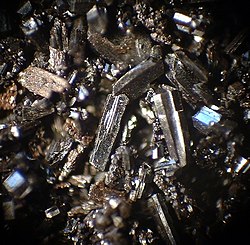
Back فوليرين Arabic Fullerenlər Azerbaijani Фулерэн Byelorussian Фулерен Bulgarian ফুলারিন Bengali/Bangla Fuleren BS Ful·lerè Catalan فولیرین CKB Fullereny Czech Fulleren Danish




| Part of a series of articles on |
| Nanomaterials |
|---|
 |
| Carbon nanotubes |
| Fullerenes |
| Other nanoparticles |
| Nanostructured materials |
A fullerene is an allotrope of carbon whose molecules consist of carbon atoms connected by single and double bonds so as to form a closed or partially closed mesh, with fused rings of five to six atoms. The molecules may have hollow sphere- and ellipsoid-like forms, tubes, or other shapes.
Fullerenes with a closed mesh topology are informally denoted by their empirical formula Cn, often written Cn, where n is the number of carbon atoms. However, for some values of n there may be more than one isomer.
The family is named after buckminsterfullerene (C60), the most famous member, which in turn is named after Buckminster Fuller. The closed fullerenes, especially C60, are also informally called buckyballs for their resemblance to the standard ball of association football ("soccer"). Nested closed fullerenes have been named bucky onions. Cylindrical fullerenes are also called carbon nanotubes or buckytubes.[1] The bulk solid form of pure or mixed fullerenes is called fullerite.[2]
Fullerenes had been predicted for some time, but only after their accidental synthesis in 1985 were they detected in nature[3][4] and outer space.[5][6] The discovery of fullerenes greatly expanded the number of known allotropes of carbon, which had previously been limited to graphite, diamond, and amorphous carbon such as soot and charcoal. They have been the subject of intense research, both for their chemistry and for their technological applications, especially in materials science, electronics, and nanotechnology.[7]
- ^ "Definition of BUCKYTUBE". www.merriam-webster.com.
- ^ "fullerite". Archived from the original on 23 October 2015.
- ^ Buseck, P.R.; Tsipursky, S.J.; Hettich, R. (1992). "Fullerenes from the Geological Environment". Science. 257 (5067): 215–7. Bibcode:1992Sci...257..215B. doi:10.1126/science.257.5067.215. PMID 17794751. S2CID 4956299.
- ^ "The allotropes of carbon". Interactive Nano-Visualization in Science & Engineering Education. Archived from the original on 18 June 2010. Retrieved 29 August 2010.
- ^ Cami, J; Bernard-Salas, J.; Peeters, E.; Malek, S. E. (2 September 2010). "Detection of C
60 and C
70 in a Young Planetary Nebula". Science. 329 (5996): 1180–1182. doi:10.1126/science.1192035. PMID 20651118. S2CID 33588270. - ^ Stars reveal carbon 'spaceballs', BBC, 22 July 2010.
- ^ Belkin, A.; et., al. (2015). "Self-Assembled Wiggling Nano-Structures and the Principle of Maximum Entropy Production". Sci. Rep. 5: 8323. Bibcode:2015NatSR...5.8323B. doi:10.1038/srep08323. PMC 4321171. PMID 25662746.
© MMXXIII Rich X Search. We shall prevail. All rights reserved. Rich X Search